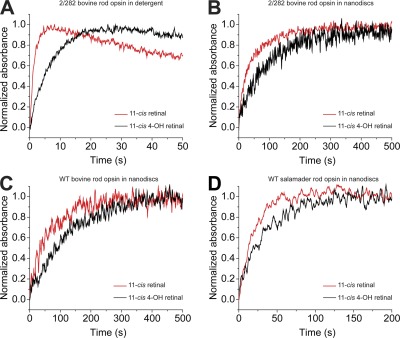Figure 5.
Pigment regeneration in solutions of four different recombinant opsin models is slower when treated with 11-cis 4-OH retinal than when treated with 11-cis-retinal. Pigment formation from opsin and retinal was monitored as an increase in absorbance at 500 nm. (A) Regeneration was analyzed in DDM detergent micelles using recombinant bovine rod opsin containing the stabilizing mutations N2C and D282C (2/282). (B–D) Regeneration in POPC lipid bilayers was analyzed using nanodiscs containing 2/282 bovine rod opsin (B), WT bovine rod opsin (C), and WT salamander rod opsin (D). Pigment regeneration is shown to proceed at a slower rate in nanodiscs than in detergent micelles; however, under all tested conditions, the rate of regeneration with 11-cis 4-OH retinal is slower than with 11-cis-retinal. Comparison of bovine 2/282 with WT rod opsins shows the stabilizing mutations do not influence the regeneration rate. Additionally, a much faster regeneration rate is shown for salamander rod opsin compared with bovine rod opsin. Data for all traces were signal averaged from three experiments. The concentrations used were 0.5 µM opsin and 3 µM retinal. Rate constants for the regenerations are presented in Table 1.

